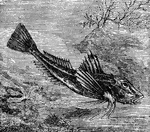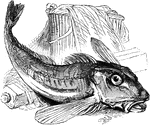87 illustrations of fish including: eel, flatfish, flathead, flounder, flying fish, fork-beard, foureyes, gar, gilt-head, globefish, goby, goldfish, goramy, graining, grayling, grouper, and gudgeon, gunnel, gurnard, and gwyniad

Goldfish
"Goldfish (Carassius auratus). A fish of the carp family Cyprinidae, Cyprinus or Carassius auratus,…

Goramy
"Reputed to be one of the best-flavored freshwater fishes in the East Indian archipelago. Its original…

Gourami
The gourami or gouramies are a family, Osphronemidae, of freshwater perciform fishes. The fish are native…

Graining
"Is found in the lakes and rivers of some parts of Europe; in its habits and food it resembles the trout,…

Grayling
"Found in the tivers of northern europe having rocky or gravelly bottoms. It resembles the trout in…

Grayling
"The Grayling is a genus of fresh-water fishes in the salmon family, distinguished from trout, etc.,…

Arctic Grayling
The Arctic grayling (Thymallus arcticus) is a freshwater fish in the Salmonidae family of salmon. It…
Grenadier
Grenadiers or rattails (less commonly whiptails) are generally large, brown to black gadiform marine…

Red Grouper
The Red Grouper (Epinephelus morios) is a fish in the Serranidae family of sea bass and groupers.

Gudgeon
"Common in Europe, and is found in streams which flow over gravelly soil. It swims in shoals, feeds…

Gudgeon
"A fresh-water fish belonging to the carp family, common in rivers of England." -Foster, 1921

Gudgeon
Gudgeon is a common name for a number of small freshwater fishes of the families Cyprinidae, Eleotridae…

Spotted Gunnel
"Or butter-fish, so called on account of the mucous secretion with which its sides are covered; it is…

Flying Gurnard
"Is from six to fifteen inches long, and is found in the Mediterranean, and also in the European and…

Flying Gurnard
A flying fish with extremely large wing like pectoral fins divided into two portions.

The Flying Gurnard (Dactylopterus Volitans)
"The Flying Gurnard has the fin rays of the pectorals connected by membranes, by which it is enabled…

Red Gurnard
"Twelve to sixteen inches long; it feeds on curstaceous animals; spawns in May or June; it is esteemed…

The Red Gurnard (Trigla Pini)
"It is of a fine, bright rose-red color, paler beneath and more vivid about the fins, of which there…

Sapphire Gurnard
"Is two feet long, and is common in the Mediterranean and other European waters; its flesh is good,…

Gwyniad
"A lake fish of Northern Europe, ten to twelve inches long; it is gregarious, and approaches the shores…

Hawken's Gymnetrus
"Eight to ten feet long, depth ten inches, thickness less than inches; color dusky green; found in the…




